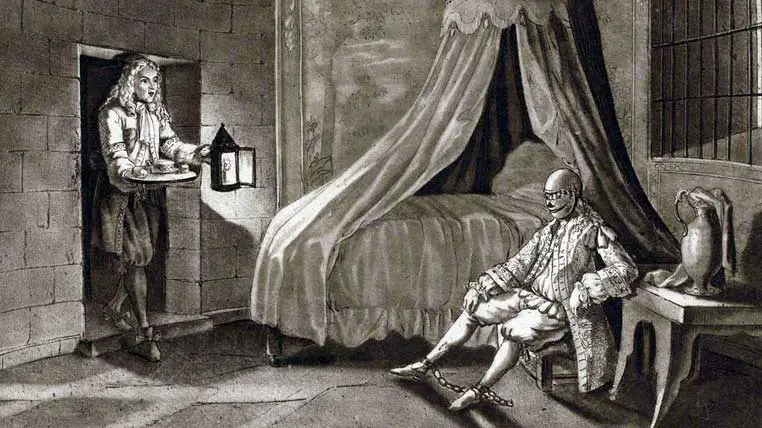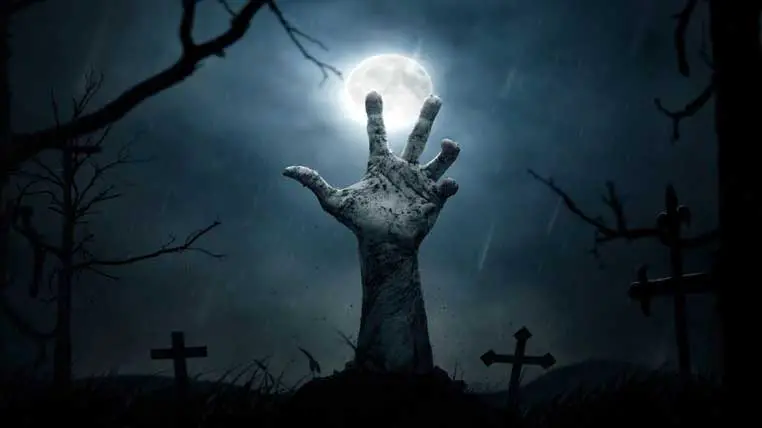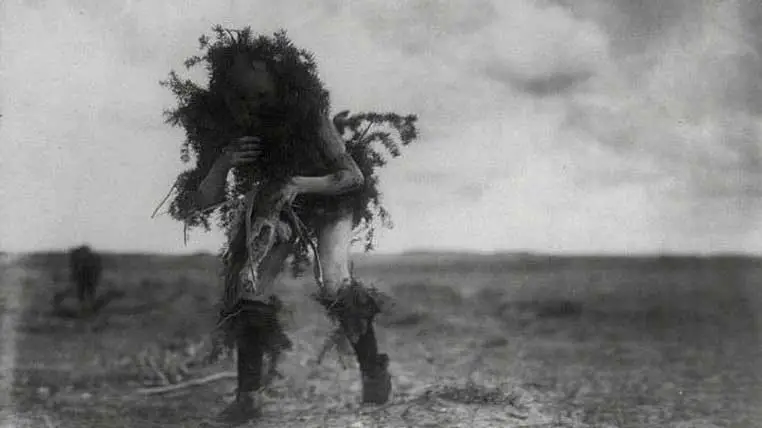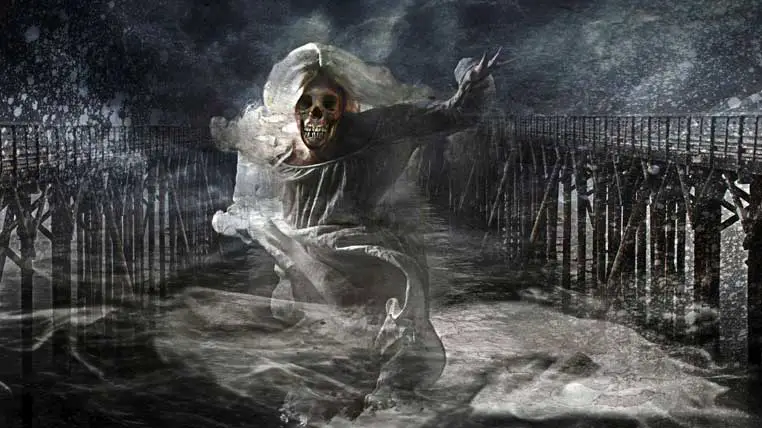The internet is full of horror stories, but most are just that – simple fantastical concoctions to tell friends around the campfire or in front of the fireplace on cold winter evenings.
However, there are myths and urban legends based on very real events. Some were published by unknown authors on obscure websites, and others were well-documented with solid evidence attesting to their veracity.
Such strange happenings, inexplicable events, unusual phenomena, paranormal experiences, or mysteries left unsolved continue to incite and stir the imagination of book authors and film directors.
Here are five of the most terrifying horror stories based on true events.

Horror Stories Based on True Events - SS Ourang Medan Ghost Ship
The first story in our series of horror stories based on true events is the strange legend of the ghost ship nicknamed the SS Ourang Medan.
The vessel sank in 1940 (according to other sources in 1947 or 1948) near the Marshall Islands (several articles give the waters off the east coast of Indonesia as the place of the sinking).
The first article referring to the ghost ship case was published on October 10, 1948, in The Albany Times (New York, United States). The report cited several reliable sources, including Elsevier’s Weekly, another well-known and respected newspaper at that time.
The horror story was then picked up and published in May 1954 in the Proceedings of the Merchant Marine Council, the official journal of the U.S. Coast Guard.
The article spoke about a mysterious vessel called the SS Ourang Medan. The name of the ship is obviously fictitious.
In the Indonesian language, the word Ourang means man, and Madan is the name of the largest city on the island of Sumatra.
Thus, in a rough translation, Ourang Medan means “the man from Medan” and makes an apparent reference to one of the variants of this horror story in which only one sailor from the SS Ourang Medan survived the tragic events.
The article published in the Proceedings of the Merchant Marine Council talks about the Silver Star, a small fishing vessel that, about 400 nautical miles southeast of the Marshall Islands, encountered another much larger drifting vessel.
The captain of the Silver Star repeatedly tried to contact the mysterious vessel, but his attempts were unsuccessful.
Concerned that something serious might be happening aboard the unknown vessel, the captain turned the small fishing boat toward the drifting ship.
From here, this horror story takes an even stranger turn. When they were less than a mile from the ship, the captain of the Silver Star received a series of S.O.S.
Initially, the messages were impossible to decipher due to a loud buzzing in the background. Then, as the fishing vessel drew closer and closer, the S.O.S. transmissions became clearer.
The captain could make out several male voices that seemed to be arguing in an unknown language.
A period of oppressive silence followed, after which a new message was received, this time very clearly:
S.O.S.! S.O.S.! The captain and officers lie dead in the conference room and on deck. All crew members are dead. It’s just me. God what a nightmare picture… I don’t want to die. Please help!
The following details turned the legend of the ghost ship into one of the most frightening horror stories.
When the fishermen of the Silver Star boarded the SS Ourang Medan, the people witnessed a chilling scene that froze the blood in their veins.
The upper deck, crew cabins, conference room, lower decks, and ship’s hold were all littered with dozens of corpses in various stages of decomposition.
Some bodies were contorted in horrible, grotesque, unnatural ways. Others were covered in a viscous, greasy substance that gave them the appearance of wax statues. The frozen faces of the dead sailors read terror.
The bodies showed no visible signs of violence, and nothing indicated an apparent cause of death.
Some articles speak of a survivor, while others say nothing of such a thing, adding to the mystery of the S.O.S. call received by Silver Star.
The captain of the fishing vessel notified the Coast Guard, who dispatched several response crews and two tugboats to tow the boat to shore.
However, a fire broke out on the SS Ourang Medan during the towing operation. The fire spread rapidly, and the ghost ship sank within minutes.
The article published in the Proceedings of the Merchant Marine Council also speaks of teams of divers who descended into the depths in an attempt to recover bodies from the sunken ship.
But each team returned to the surface with the same puzzling response: “The ship is completely empty. We couldn’t find any human remains down there.”
The official version released by the authorities for this horror story says that the SS Ourang Medan was carrying dangerous chemicals, and one of the containers cracked, releasing the toxins.
However, the explanation is not credible, considering that the transport was not registered anywhere, which is mandatory, especially in the case of the transport of dangerous substances.
The wreck of the SS Ourang Medan still lies today at the bottom of the ocean, somewhere near the Marshall Islands. Most vessels avoid that area, perhaps out of superstition or perhaps out of fear.
Those who dare venture near the spot where the SS Ourang Medan sank say that, sometimes, the radios go crazy, and behind the static noise, a man’s voice can be heard pleading for help.

Horror Stories - The Man in an Iron Mask
Among the most popular horror stories is the terrifying legend of the man in the iron mask.
Most people are already familiar with Alexandre Dumas’ novel, The Count of Monte Cristo. Still, only some know that the novel’s story is based on one of the most controversial enigmas of French history.
Who was the prisoner nicknamed “the man in the iron mask”?
Some historians believe that he was the twin brother of King Louis XIV and the rightful heir to the throne of France. In contrast, others refute the hypothesis and believe that the “man in the iron mask” was an insignificant historical figure, possibly a valet or servant at the king’s court.
The first document that mentions the existence of this enigmatic prisoner dates from 1669 and belongs to Benigne d’Auvergne de Saint-Mars, an officer of the Pignerol fortress.
In an official report to his superiors, he mentions five detainees “of interest,” one of whom is described as “the man in the iron mask.”
Ten years later, in 1679, Benigne d’Auvergne was promoted, offering him the post of Governor of the French islands of Saint Honorius and Saint Margaret.
During all official visits that Benigne d’Auvergne made as governor, he was accompanied by a mysterious man wearing an iron mask. For many historians, this reinforced the idea that the Pignerol prisoner was, in fact, a key figure.
Then, in 1698, King Louis XIV issued an order by which Saint-Mars became Governor of the Bastille. And this time, the former officer was repeatedly seen in the company of the man in the iron mask.
The man was then imprisoned in the Bastille under the watchful eye of Saint-Mars. Four years later, in 1702, the mysterious prisoner died.
But the events that followed the man’s death raised even more questions about the man’s identity.
Thus, the prisoner’s death was reported with inexplicable delay, and the burial took place in great haste and secret. The prison doctor was not allowed to examine the remains (as was the standard procedure in such situations), and the death certificate “disappeared” in a mysterious fire.
All of the prisoner’s personal belongings were either thrown away or burned.
The end of the mysterious man with the iron mask meant the beginning of a heated debate, with several hypotheses being launched.
Some believed that the man in the iron mask was, in reality, the twin brother of King Louis XIV and, therefore, a threat to the throne.
Others advanced an even stranger hypothesis, stating that the mysterious masked prisoner would have been the real Louis XIV and that an impostor would have been on the throne of France.
Another version of this horror story suggests that the prisoner was a servant named Eustache Dauger, imprisoned for having an affair with Queen Anne of Austria, wife of Louis XIII, and mother of King Louis XIV.
Another hypothesis was launched by Princess Elisabeth Charlotte d’Orleans, who was convinced that the prisoner was not of noble birth, but rather an English lord or spy imprisoned for a plot against the king.
Voltaire (real name François-Marie Arouet), a prominent figure of the French Enlightenment and one of the greatest philosophers and writers of all time, wrote about the mysterious prisoner in his book, Siecle de Louis XIV, highlighting that he was constantly moved from one dungeon to another without his face ever being seen.
Voltaire had the opportunity to learn more about the man in the iron mask when he was imprisoned in the Bastille.
Thus, according to the great philosopher, the man with the iron mask would have been a character from high society, something proven by the special treatment he enjoyed behind bars.
The mysterious prisoner’s cell was spacious, always clean, and decorated with style. The guards treated him with respect and obeyed his demands.
The cryptologist Etienne Bazeries, in turn, came up with a theory about the man’s identity after deciphering, he says, a series of secret codes in the letters of Louis XIV.
In the letters, the King of France spoke of a prisoner “of great value,” a brilliant commander who had made a decisive contribution to the defeat of the French army in northern Italy.
According to Bazeries, Commander Vivian Labbe was imprisoned in the dungeons of Pignerol, allowed to walk freely during the day, but only with a mask over his face.
However, the theory put forward by Bazeries has been contradicted, with more evidence showing that Vivian Labbe was released from prison around 1700.
The mystery of the prisoner with the iron mask has lasted more than 300 years, and the story of his tragic destiny continues to fascinate today.
Being condemned to a life in prison while wearing the same hideous mask day and night for more than 33 years is probably a worse punishment than death.

Horror stories - The Curse of Timur Lenk
The terrible curse of Timur Lenk is among the most well-known horror stories based on real events.
The myth of Timur Lenk’s curse is rooted in a bizarre coincidence that happened during World War II (1939-1945).
On June 19, 1941, a group of Soviet archaeologists led by Mikhail M. Gerasimov, Lev V. Oshanin, and V. Zenkova excavated an ancient tomb in the Gur-e Amir region, Samarkand, Uzbekistan.
The tomb belonged to the dreaded Mongol conqueror Timur Lenk (Timur the Lame, 1336-1405).
Timur Lenk was the founder of the Mongol Empire, with its capital in Samarkand (today in Uzbekistan), and the powerful Timurid dynasty, which lasted until 1507.
Timur Lenk’s empire was vast and stretched from the shores of the Caspian Sea to western China and Syria to Pakistan. Timur Lenk was known to be a heavy drinker, which led to his death in the winter of 1405 during a military campaign against the Ming dynasty.
The place where the Mongol conqueror was buried represented one of the great secrets of the former Mongol Empire.
That was until 1941, when the tomb was discovered by Soviet archaeologists.
Various legends have circulated about the tomb of Timur the Lame, including the myth that the tomb was protected by an ancient curse.
When archaeologists unearthed the entrance to the tomb, it was said that the following message was inscribed above the stone slab covering the door: “When I rise from the dead, the world will tremble.”
Also, when Gerasimov opened the sarcophagus containing the body of the dreaded Mongol conqueror, he noticed another ominous message: “Whoever desecrates my tomb will unleash a more terrible invader than I was.”
Timur Lenk’s curse turned out to be as real as it gets.
Three days later, on June 22, 1941, Nazi Germany, led by Adolf Hitler, launched Operation Barbarossa, the largest military invasion in history.
The large-scale attack on the Soviet Union involved 3.8 million soldiers, nearly 8,000 tanks and military vehicles, over 5,000 aircrafts, and over 20,000 artillery pieces.
During the five months of the invasion, over six million soldiers lost their lives, the vast majority of them from the ranks of the Red Army.
Timur Lenk’s body was reburied with all appropriate Islamic rites in November 1942, just before the Soviet victory in the Battle of Stalingrad, one of the bloodiest military engagements of World War II.

Horror Stories - Messages from Beyond
This horror story is quite extraordinary as no one has been able to provide a logical explanation for the series of gruesome events that occurred on September 20, 1885.
A few weeks before the events in question, a man named Thomas Kipling, from Pennsylvania, United States, found an envelope slipped under the door of the house he was renting.
The envelope was unstamped and had neither sender nor addressee, indicating that the message had been delivered directly by an unknown person.
When he opened the letter, Thomas froze.
He immediately recognized the writing of his younger brother Simon, who had died in the summer of 1872 after long suffering from a persistent illness.
In the letter, he revealed to Thomas that he was suffering from a mental disorder and felt very weak, but he was alive and would soon come to visit him.
The Victorian era (1832-1901) was a time of superstitions, legends, horror stories, and beliefs in supernatural creatures (evil spirits, vampires, werewolves, and other bloodthirsty monsters).
Obviously, such a message horrified Thomas, who immediately demanded the exhumation of his brother’s body.
The request was approved, and Thomas, alongside a couple of lawmen, a priest, the coroner’s assistant, and several curious people, dug up the coffin in which Simon’s rotting body should have been.
But here is where the horror story turns even more bizarre and unsettling.
To the amazement of those present, the coffin turned out to be empty, even though dozens of people had attended the funeral and could swear that Simon’s body was in the casket when it was lowered into the ground.
The news spread quickly, and fear gripped the small community.
People barricaded their doors and windows, terrified that some unclean spirit would descend upon them, bringing misfortune and death.
To keep things under control, the law enforcement officers organized patrols during the night, while several other policemen were posted to guard the cemetery and the house where Thomas lived.
After a few weeks in which nothing out of the ordinary happened, the general hysteria subsided, and the citizens returned to their daily routine.
On the night of September 20-21, however, several men walking home noticed a strange figure walking among the graves.
Frightened, they raised the alarm. Law enforcement was immediately mobilized, and to their great astonishment, they discovered that the grave where Simon’s body was supposed to be had, once again, been dug up.
In the pit, they found an old coffin, and inside it, two bodies embraced, identified as belonging to the two Kipling brothers.
Both bodies were in an advanced state of decay, with the coroner concluding in the official report that the two had been dead for at least 10 years.

Horror stories - Photographs from Another World
Numerous horror stories are centered around photographs that inexplicably capture so-called “shards from another world.”
But the incident in 1997, from a small town in the United States, is truly incredible.
Rita Swift, a single mother, decides to move with her ten-year-old son to a quieter area on the outskirts, away from the hustle and bustle of the city.
Luck quickly turns to the young mother, who finds a beautiful house in a perfect area, which she buys at an extremely favorable price, well below the market price.
While tidying through the house’s attic, Rita discovers a roll of film on which is written: “Filmed in the yard, 1969.”
Using an old Bell & Howell 256 machine, the woman projects a few images from the film onto a wall.
Rita quickly recognizes the house she has just moved into, but the first shots turn out to be as mundane as possible, depicting a family dining in the courtyard.
She also notices a minor flaw on several frames, a faint, almost invisible shadow, most likely due to a lens defect.
But the last three frames seem to be taken from another movie.
The camera with which the first photos had been taken, the ones in the house’s yard, was a Brownie Hawkeye 20 model, a high-performance camera, very popular in the late 60s – early 70s.
But the last three photos were different.
Much darker, blurry, and reminiscent of the celluloid photographs typical of the first camera models, probably from the late 19th century.
In the first photo, Rita notices three completely naked men dancing ritualistically on the shore of a lake.
In the background, somewhere on the right side of the photo, there is a shadow, a lone figure that seems to be watching the dance of the three shamans intently.
The second photo has in the center a massive quadruped, over two meters tall, with long, thick fur, a creature somewhat reminiscent of a bison. The animal is surrounded by a group of Native Americans with painted faces.
And in this photo, Rita makes out the mysterious shadow hidden somewhere behind the group of natives.
The third frame features four women seated around a fire. One of the women is missing her head, and the mysterious shadow – now taking on more of a human form – is standing right next to the lifeless body.
Moreover, her eyes are fixed on the camera, as if she knows someone has just photographed her.
Rita showed the film to several experts, who confirmed that the images were not faked.
But the experts failed to explain why the significant difference in quality between the first frames and the last three images, all of which are part of the same film.
Rita’s story and the three strange photos were published in the local newspaper and sparked heated controversy, becoming one of the most well-known horror stories of the time.
Although many theories have been floated, no one could identify the lake in the first photo or the species of mammal appearing in the next frame.
But another curious thing happened.
The reporter who interviewed Rita asked her permission to photograph, from the street, the house where the young mother had just moved, intending to use that photograph in the newspaper.
The horror story of otherworldly images ends as bizarrely as it began, as the photo was never published.
During development, a defect was identified on the film, probably due to a problem with the camera lens – a fainted shadow that seemed to embrace a good part of the house.
At Ancient Theory we only use trusted sources to document our articles. Such relevant sources include authentic documents, newspaper and magazine articles, established authors, or reputable websites.
- Ourang Medan - wikipedia.org. [Source]
- Rob Morphy - Death Ship: The Ourang Medan Mystery.
- The Myth of the Ourang Medan Ghost Ship, 1940. The Skittish Library.
- Phyllis Raybin Emert - Mysteries of Ships and Planes. Tom Doherty Associates, Inc., New York, 1990.
- Afsar Ahmad - How Conqueror Timur Continues To Scare Many After His Death. news18.com.
- Richard Cavendish - The Death of Tamerlane. History Today, Vol. 55, 2005.
- Man in the Iron Mask - wikipedia.org.
- Evan Andrews - Who was the Man in the Iron Mask? history.com. [Source]
- Spooky! Top 10 Unexplained Phenomena - livescience.com.
- Brent Swancer - More Strange and Mysterious Photographs of Unidentified People. mysteriousuniverse.org.






